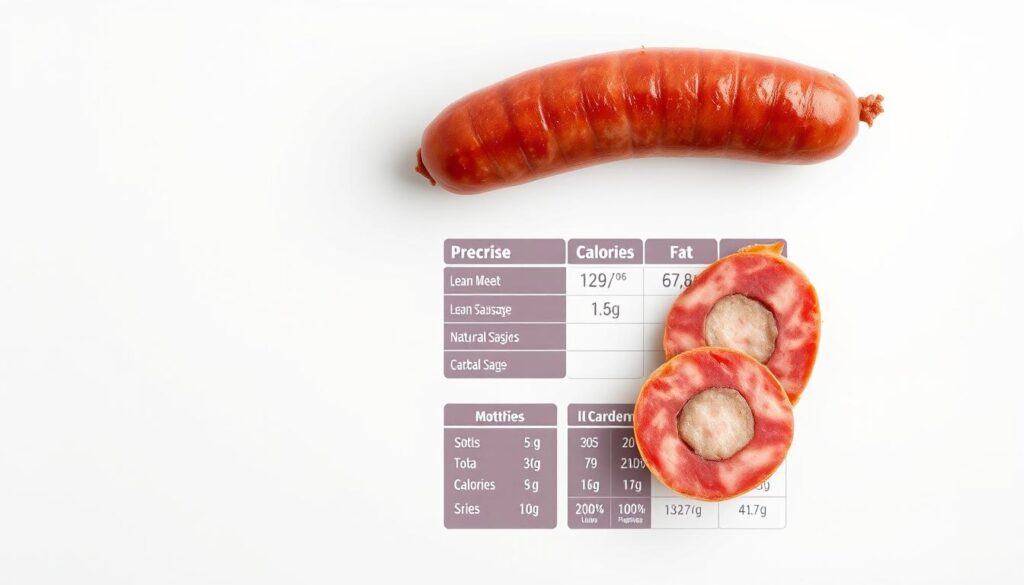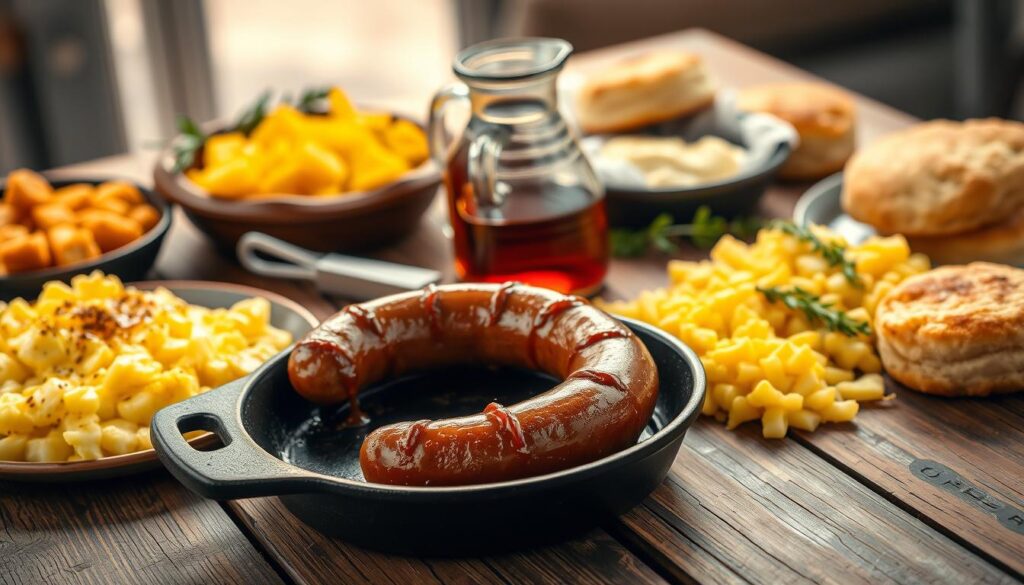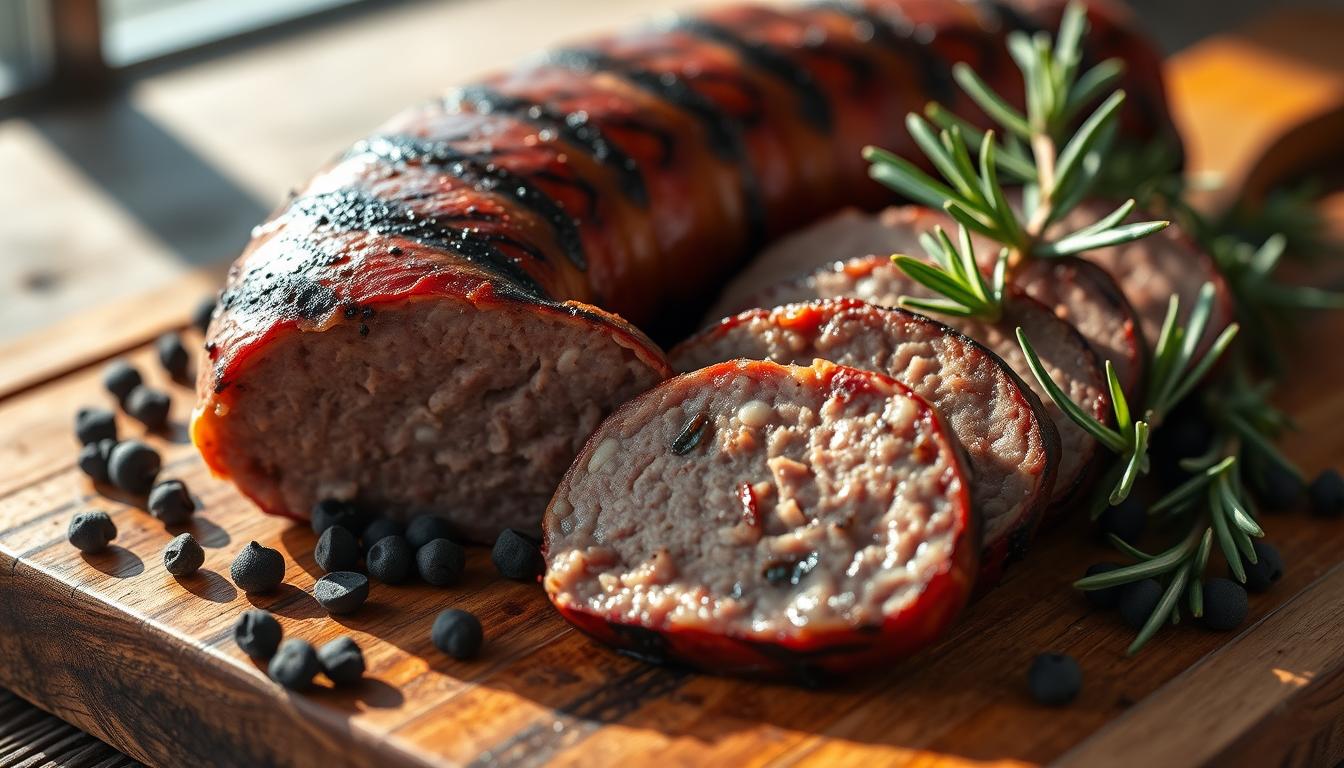Imagine waking up to the sizzling sound of beef breakfast sausage crackling in a hot skillet. The rich aroma fills your kitchen, promising a protein-packed start to your morning. It energizes you from the first bite. Beef sausage isn’t just another breakfast option – it’s a culinary experience that transforms an ordinary morning into something extraordinary.
Crafting your own beef breakfast sausage lets you control every ingredient. This ensures a fresh, flavorful meal that beats store-bought options. Whether you’re a home cook looking to impress your family or someone seeking a nutritious breakfast alternative, beef sausage offers a delicious solution.
The beauty of homemade beef breakfast sausage lies in its versatility. You can customize the spices, adjust the fat content, and create a truly personalized morning meal. This meets your nutritional needs and taste preferences.
Table of Contents
Understanding Beef Breakfast Sausage: A Protein-Packed Morning Choice
Beef breakfast sausage is a tasty and nutritious start to your day. It’s packed with protein and essential nutrients. This makes it a great choice for a hearty morning meal.
Beef breakfast sausage is a top pick for morning protein. A 3 oz serving gives you:
- 14-16 grams of high-quality protein
- 200-250 calories
- Essential vitamins and minerals
Nutrition experts love beef breakfast sausage for its nutrient-rich profile. It’s full of iron, zinc, and B vitamins, like vitamin B12. These nutrients help boost energy and keep muscles strong.
| Nutrient | Amount per 3 oz Serving |
|---|---|
| Protein | 14-16 grams |
| Calories | 200-250 |
| Fat | 15-20 grams |
| Carbohydrates | Less than 1 gram |
Using lean ground beef in your sausage can cut down on saturated fat. Yet, it keeps the protein levels high. With different flavors like Tex-Mex and Mediterranean, beef breakfast sausage is versatile for any morning.
Beef breakfast sausage: A delicious protein powerhouse to fuel your day!
Essential Ingredients for Homemade Beef Breakfast Sausage
Making the perfect homemade breakfast sausage begins with picking the right ingredients. Your recipe will shine with the right mix and prep. Let’s look at the key parts for a tasty beef breakfast sausage.
Best Cuts of Beef for Sausage Making
Choosing the right beef is key for your homemade sausage. For the best taste and texture, use 85% lean ground beef. This mix of lean and fat is perfect.
- 85% lean ground beef (1 pound)
- Freshly ground beef for the best taste
- Avoid very lean cuts that can make sausage dry
Seasoning Blend Recommendations
The secret to great homemade sausage is in its seasoning. Here’s a blend that will make your breakfast recipe stand out:
- 2 teaspoons brown sugar
- 1.5 teaspoons dried sage
- 1.5 teaspoons salt
- 0.5 teaspoons black pepper
- 0.125 teaspoons garlic powder
- 0.125 teaspoons dried thyme
- Pinch of cayenne
- Pinch of cloves
Optional Add-ins and Flavor Enhancers
To make your homemade sausage extra special, try these optional ingredients:
- 1/4 cup water for extra moisture
- 2 tablespoons olive oil for frying
- Fresh herbs like chopped parsley
- Red pepper flakes for more heat
Pro tip: Mix the seasonings well into the ground beef for even flavor. You’ll get a delicious, restaurant-quality sausage in your kitchen.
Step-by-Step Guide to Making Perfect Beef Breakfast Sausage
Making your own beef breakfast sausage is a simple way to make mornings special. With the right ingredients and techniques, you can make sausages that make breakfast better.
Begin by picking high-quality beef with a 75:25 meat-to-fat ratio. This mix makes sausages juicy and full of flavor, pleasing everyone at the table.
- Gather your ingredients:
- 2 lbs well-marbled beef
- 3 tsp sea salt
- 1 Tbsp whole yellow mustard seed
- 1 tsp black pepper
- 1/2 tsp salt-free seasoning
- 1 cup ice-cold water
- Prepare the meat:
- Cut 1/4 of the beef into small dice
- Grind remaining 3/4 of the beef
- Mix the ingredients:
- Combine meat with seasonings
- Mix by hand for 1 minute
- Add ice-cold water
Pro tip: Let the sausage mixture rest in the refrigerator overnight to enhance flavor development.
When cooking, aim for an internal temperature of 165°F. Bake at 350°F for 1 hour, then broil for 5 minutes on each side. This will give you a golden-brown exterior.
Your homemade beef breakfast sausage can be stored in the fridge for 3-5 days or frozen for up to 3 months. It’s a tasty and convenient breakfast choice.
Nutritional Benefits and Health Considerations
Beef breakfast sausage is a great choice for a protein-packed breakfast. Knowing its nutritional profile helps you make better food choices. This supports your health and wellness goals.

Beef breakfast sausage has a mix of macronutrients and micronutrients. These can help meet your daily nutritional needs.
Protein and Essential Nutrients
Beef breakfast sausage is a top-notch protein source. It has about 12.9g of protein per 100g. This protein supports:
- Muscle growth and repair
- Sustained energy levels
- Metabolic function
Caloric Content and Portion Control
Beef breakfast sausage has 327 calories per 100g. It’s important to control your portions to enjoy it without overeating.
| Nutrient | Amount per 100g |
|---|---|
| Calories | 327 kcal |
| Protein | 12.9g |
| Fat | 18g |
| Carbohydrates | 4.61g |
Dietary Considerations
Beef breakfast sausage has nutritional benefits but also health considerations:
- High sodium content (904mg per 100g) may impact heart health
- Saturated fat levels require moderation
- Processed meat consumption should be balanced
Nutrition is about balance and making informed choices that support your overall health and wellness.
Talking to a nutritionist can help you add beef breakfast sausage to a balanced diet. This way, you can avoid potential health risks.
Cooking Methods and Temperature Guidelines
Creating the perfect beef breakfast sausage is all about mastering different cooking techniques. This easy breakfast recipe can be prepared in many ways, ensuring tasty results. Knowing the best cooking methods will help you get a juicy inside and crispy outside every time.
- Pan-Frying: Cook sausages for 10-15 minutes, turning every two minutes
- Oven Baking: Preheat to 350°F, bake for 20 minutes, flipping halfway
- Grilling: Use indirect heat for 15 minutes, checking internal temperature
Food safety is key when cooking beef breakfast sausage. The internal temperature must hit 160°F to kill bacteria. Use a meat thermometer to check if it’s done. This keeps your breakfast both tasty and safe.
Here are some tips for cooking perfect beef sausage:
- Space sausages apart for even cooking
- Use a lid while cooking to distribute heat evenly
- Add half a cup of water when pan-frying to speed up cooking
- Create a “butterfly” cut for larger sausages to reduce cooking time
By following these tips, you’ll become a pro at cooking beef breakfast sausage. You’ll start your day with a protein-packed breakfast.
Pairing Your Beef Breakfast Sausage with Complementary Dishes
Make your breakfast special with beef breakfast sausage. It turns a simple meal into a tasty adventure. The right dishes make your morning meal both delicious and nutritious.
Classic Breakfast Combinations
Traditional pairings highlight beef breakfast sausage’s flavor. Try these classic combos:
- Scrambled eggs with crispy sausage patties
- Hash browns topped with crumbled breakfast sausage
- Buttermilk biscuits served alongside grilled sausage links
- Hearty breakfast casseroles featuring beef sausage as a key ingredient
Modern Serving Suggestions
Try new breakfast ideas with beef breakfast sausage:
- Sausage-stuffed mini quiches
- Breakfast burritos with seasoned beef sausage
- Quinoa breakfast bowls topped with sliced sausage
- Savory breakfast muffins incorporating ground sausage
Sauce and Condiment Pairings
| Sauce/Condiment | Flavor Profile | Best Pairing |
|---|---|---|
| Maple Syrup | Sweet and Rich | Sausage Patties |
| Spicy Mustard | Tangy and Sharp | Sausage Links |
| Hollandaise Sauce | Creamy and Luxurious | Sausage with Eggs Benedict |
| Hot Sauce | Spicy and Bold | Crumbled Sausage in Breakfast Hash |

Make your breakfast both tasty and healthy. Choose dishes and sauces that complement each other. This way, you’ll have a memorable and energizing morning meal.
Storage Tips and Meal Prep Strategies
Keeping your homemade breakfast sausage fresh is key. Smart storage keeps the flavor and quality up. When you make beef breakfast sausage, the right storage helps it last longer and makes cooking easier.
Refrigeration and Freezing Techniques
For a few days, keep your sausage in the fridge in an airtight container. For longer storage, freeze it. Wrap each portion in plastic or a freezer bag to avoid freezer burn. Frozen sausage stays tasty for up to 3 months.
Batch Cooking Strategies
- Make big batches of sausage when you have time
- Divide sausages into single servings
- Mark containers with when you made them
- Freeze in vacuum-sealed bags for longer storage
Meal Prep Efficiency
Batch cooking your sausage saves time in the morning. Studies show meal planning can cut dinner prep time by 60%. This makes your breakfast routine quicker and easier.
| Storage Method | Duration | Best Practices |
|---|---|---|
| Refrigeration | 3-4 days | Use airtight containers |
| Freezing | Up to 3 months | Wrap individually, label with dates |
Pro tip: Cooking in bulk can save 50% on food costs. It also means you cook less often during the week.
Thawing and Reheating
Thaw frozen sausage in the fridge overnight for the best taste. Reheat in a skillet or oven to keep it crispy and juicy. Don’t use the microwave to keep the texture right.
Environmental Impact and Sustainable Beef Sourcing
When you enjoy beef breakfast sausage, knowing its environmental impact is key. The beef industry is working hard to be more sustainable. They aim to lessen their ecological footprint.
Meat, including beef, is a big contributor to global emissions. It takes a lot of resources to produce beef. Here’s what it takes to make one kilogram of beef:
- 18 times more land
- 10 times more water
- 9 times more fuel
- 12 times more fertilizer
- 10 times more pesticides compared to plant protein
Ethical Farming Practices
Sustainable beef sausage is more than just good for the planet. The Global Roundtable for Sustainable Beef (GRSB) has set five key principles. These focus on using resources wisely and caring for animals. This ensures your sausage comes from farms that value ethics.
Reducing Carbon Footprint
Methane from cattle is a big part of greenhouse gas emissions. New farming methods are being developed to lessen these effects. Pasture-raised cattle and regenerative farming can cut down beef’s carbon footprint a lot.
Supporting Local Producers
Choosing local beef sausage helps the environment. Local farmers often use greener practices and cut down on emissions from transport. By backing these farmers, you help make food systems more sustainable.
Your choice of beef breakfast sausage matters. Look for producers who care about sustainable and ethical beef.
Common Mistakes to Avoid When Preparing Beef Breakfast Sausage
Making the perfect homemade breakfast sausage needs skill and focus. Many home cooks make mistakes that can ruin their dish. Knowing these common errors will help you make delicious beef breakfast sausage every time.
- Meat Handling Mistakes
- Avoid over-mixing the meat, which can result in tough sausages
- Ensure meat content stays between 75% to 80% for optimal texture
- Keep meat cold during preparation to maintain proper consistency
- Seasoning Challenges
- Use precisely 2% seasoning blend relative to meat mixture
- Balance spices like brown sugar, sage, garlic powder, and red pepper flakes
- Prevent over-seasoning or under-seasoning by measuring carefully
- Cooking Temperature Errors
- Maintain internal cooking temperature of 165°F for food safety
- Start cooking in a cold pan to allow proper fat rendering
- Avoid overcrowding the pan to ensure even heat distribution
Professional chefs say using a meat thermometer is crucial for even cooking and safety. Cooking in a pan or grill adds more flavor than other methods. When browning sausages, aim for a caramelized exterior to improve texture and taste.
For your homemade breakfast sausage, precision is key. Choose the right beef cuts, measure seasonings accurately, and watch cooking temperatures. These tips will help you make sausages that impress everyone.
Conclusion
Making your own beef breakfast sausage is more than a fun cooking project. It’s a way to make your morning meal special and healthy. You’ve learned how to make a tasty, protein-rich breakfast at home.
This journey is not just about the taste. It’s also about making good food choices and caring for the planet. Your choice to make homemade sausage shows you care about both flavor and the environment.
Now, you can get creative in the kitchen. Try new seasonings, find eco-friendly ingredients, and share your sausage recipes. Every batch you make lets you improve your skills and enjoy a breakfast that’s just right for you.
Creating beef breakfast sausage is about more than just eating. It’s about knowing your food, supporting fair practices, and starting your day off right. Keep trying new things, learning, and most importantly, keep cooking!
FAQ
What makes beef breakfast sausage different from traditional pork sausage?
Beef breakfast sausage has a richer taste and is leaner than pork sausage. It’s a great choice for those who prefer beef. It’s also a good option for a leaner protein source.
How do I ensure my homemade beef breakfast sausage stays juicy and flavorful?
Use a mix of lean and fatty beef cuts for juiciness. Don’t overwork the meat and avoid overcooking. Mix fresh seasonings gently into the meat to keep it moist and flavorful.
Can I make beef breakfast sausage if I’m watching my calorie intake?
Yes, you can make a diet-friendly version. Choose leaner beef cuts and control your portions. Use herbs and spices for flavor without extra calories. Making smaller patties helps with portion control.
What are the best cuts of beef for making breakfast sausage?
Chuck, sirloin, and round cuts are best for beef breakfast sausage. They offer a good balance of lean meat and fat. Ground chuck is recommended for its 80/20 lean-to-fat ratio.
How long can I store homemade beef breakfast sausage?
Store it in an airtight container in the fridge for 3-4 days. Freeze for up to 3 months. Wrap tightly in freezer paper or vacuum-seal to prevent freezer burn.
Is beef breakfast sausage a good source of protein?
Yes! It’s a great protein source, offering about 6-8 grams per serving. It has all essential amino acids. It’s a protein-packed way to start your day.
Are there any sustainable options for sourcing beef for homemade sausage?
Choose grass-fed, locally sourced beef from farms that practice sustainable farming. Grass-fed beef is better for the environment and often higher quality. Buy from local farmers’ markets or reputable ranches.
What are some common seasonings used in beef breakfast sausage?
Traditional seasonings include sage, thyme, black pepper, and garlic powder. Some recipes add fennel seeds or paprika. Experiment with different herbs and spices to find your favorite flavor.
Source Links
- Quick & Easy Breakfast Sausage Recipe in 15 minutes (+Video) – https://dontwastethecrumbs.com/breakfast-sausage-recipe/
- 37 Savory Breakfast Sausage Recipes – https://www.tasteofhome.com/collection/breakfast-sausage-recipes/?srsltid=AfmBOopLQTo3Tugic5PqUTz7UFisJF8p3xQUsWGi38JhicD017NvFxsM
- Easy Homemade Breakfast Sausage – https://www.hypothyroidchef.com/blog/easy-homemade-breakfast-sausage
- Beef Breakfast Sausage: Easy & Delicious Recipe – https://www.anydayrecipes.com/beef-breakfast-sausage/
- 5 Healthy Breakfast Meats + What to Avoid | Nourish – https://www.usenourish.com/blog/healthy-breakfast-meats
- Homemade Beef Breakfast Sausage – https://thecookful.com/beef-breakfast-sausage/
- Easy Beef Sausage Recipe – Healthy Recipes Blog – https://healthyrecipesblogs.com/homemade-sausage/
- Easy Homemade Breakfast Sausage Recipe (Links or Patties) – https://homesteadingfamily.com/homemade-breakfast-sausage-recipe/
- How to Make Homemade Sausage (VIDEO Recipe) – https://natashaskitchen.com/how-to-make-homemade-sausage-video/
- How to Make Sausage At Home – https://www.smokedbbqsource.com/how-to-make-sausage-at-home/
- Is Breakfast Sausage Keto-Friendly? – https://www.castironketo.net/friendly/meat/processed/sausage/breakfast-sausage/
- How Eating Processed Red Meats Can Increase Your Risk For Dementia And Cardiovascular Disease – https://www.henryford.com/blog/2024/12/processed-red-meats-and-your-risk-for-dementia-and-cardiovascular-disease
- Ultimate Guide to Sausage – https://www.smokehouse.com/blog/post/the-ultimate-guide-to-sausage?srsltid=AfmBOoozL72wXPl_BrQOSQOsQkE1kitsTOiZOMfVdJXr1VMAZpXF6-cR
- How to Cook Sausage: The 5 Best Ways – https://www.gourmetfoodstore.com/how-to-cook-sausage-16350
- How To Cook Sausage in the Oven – https://www.101cookingfortwo.com/cook-sausage-oven/
- The Best Sides to Go With Sausage – Premio Foods – https://www.premiofoods.com/best-sides-to-go-with-sausage/
- 37 Savory Breakfast Sausage Recipes – https://www.tasteofhome.com/collection/breakfast-sausage-recipes/?srsltid=AfmBOopkYVW5Qj0GSCizznUnZufLD9qNFcPyobxL3MVyU1jUQs0fsZyb
- Building Up A Long-Term Food Storage Supply – https://homesteadingfamily.com/building-up-your-long-term-food-storage-supply/
- The Ultimate Guide to Batch Cooking | 3 Money-Saving Methods – https://dontwastethecrumbs.com/how-to-save-time-money-batch-cooking/
- Responsible Sourcing – https://corporate.mcdonalds.com/corpmcd/our-purpose-and-impact/food-quality-and-sourcing/responsible-sourcing.html
- Sustainable Meat: The Best and Worst Kinds, Ranked by Sustainability Experts – https://www.thehealthy.com/nutrition/sustainable-meat/
- New-Meat Environmental Impact | Redefine Meat – https://www.redefinemeat.com/environment/
- The Best Tips For Cooking Sausage, According To Industry Experts – Foodie – https://www.foodie.com/1772314/best-sausage-cooking-tips/
- The Seasoning Mistake To Avoid When Making Homemade Sausage – Tasting Table – https://www.tastingtable.com/1696233/homemade-sausage-seasoning-mistake/
- breakfast sausage – https://www.cookinghub.com/recipe-ingredient/breakfast-sausage/
- Beef Breakfast Sausage: Savory Morning Delight – https://onestophalal.com/blogs/info/savoring-the-flavor-exploring-the-allure-of-beef-breakfast-sausage
- Homemade Breakfast Sausage Made Easy – https://www.psseasoning.com/blogs/news-events/homemade-breakfast-sausage-made-easy?srsltid=AfmBOoqzy_PPofpoDvCSHbSIogkuCQfTgdJETRLPgjcFnJnq2qp_cDvG









